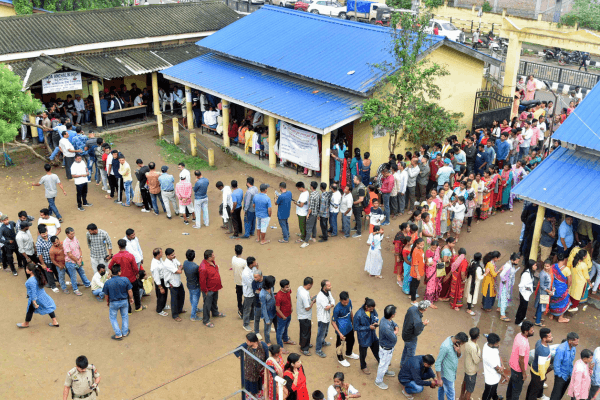Lisa Getches was walking down the street after a service at Holy Name Cathedral in Chicago — a church she only recently began attending after watching virtual services — when she bumped into a vendor selling StreetWise magazines.
Getches, who is 57, used to read the street paper when she last worked downtown over 20 years ago; she left the workforce in the 1990s to care for her young son. She missed key workplace modernizations, she said, like Microsoft Windows, which made reentry into the workforce daunting.
Now, after just two months selling the magazine near Fourth Presbyterian Church downtown, StreetWise is helping Lisa apply to more structured jobs. A big fan of museums and astronomy, she’s hoping to land a job at the Chicago Field Museum or maybe Adler Planetarium.
“It’s been a really great influence on my life,” Getches said.
StreetWise is one of hundreds of street newspapers around the world, publications that give people experiencing housing or job insecurity an accessible way to earn an income. The Chicago-based paper currently works with just over 100 vendors, with 30 of those people, like Lisa, in its jobs program. Vendors buy the papers for a small fee and then sell them for a few dollars, plus — hopefully— a tip. StreetWise cropped up during the street newspaper movement of the ’90s, and several papers still exist in large cities across the United States.
The movement began in New York City as a way to address rising levels of homelessness and combat negative media portrayals of homeless communities, according to the National Coalition for the Homeless. Proponents wanted to both help people earn money and also illuminate their stories and raise awareness of systemic issues. In the decades since, workers at these publications and scholars have debated whether or not street newspaper organizations have been able to achieve that mission.
For street newspapers, maintaining a viable business model, attracting readership, and centering people experiencing homelessness has been a triple challenge, said Kevin Howley, professor of media studies at Depauw University.
“That’s always been one of the tensions: Whose voices are being published or amplified?” Howley said. “Is it the people that are literally out on the streets, or, are they the ones doing most of the vending and occasional pieces?” And as Howley sees it, not every street newspaper could successfully manage that tension.
Different approaches
According to Howley, there are two competing philosophies for street newspapers: One philosophy sees the newspapers primarily as an economic venture; the other sees the newspapers as a vehicle for social change. These two philosophies often clashed, as occurred at The Big Issue, a British street newspaper started in the early '90s.
“[The Big Issue’s] approach — glossy covers, a paid, professional writing staff, general interest features, celebrity news, advertisements for upscale products, and a modest, but regular column featuring work by homeless people — alienated street paper workers whose vision was more activist oriented, less entrepreneurial,” Howley wrote in his book, Community Media: People, Places and Communication Technologies.
Boston’s Spare Change and Seattle’s Real Change exist more on the activist end of the spectrum. Both newspapers were founded by organizer Timothy Harris, who stepped down from the helm of Real Change after 26 years last November, citing a need for “new eyes, fresh energy and more diverse leadership.”
In a farewell address on Real Change’s website, Harris emphasized the organization’s commitment to fighting systematic inequality at the ground level. “Real Change, at our best, has engaged in bold, intersectional advocacy and organizing that brings big results. The most far-reaching wins in our history — stopping a new municipal jail from being built and foiling an attempt to criminalize panhandling — were organized in alliance with organizations like the ACLU and the NAACP,” he wrote.
Alex Ramirez, who was the editor-in-chief of Spare Change in Boston from 2017 to 2019, said, in his experience, the tension between selling magazines and supporting vendors was complicated. While the paper sometimes focused on trending topics, it also prioritized marginalized communities in Boston. And though he wished there were more opportunities for folks experiencing homlessness to earn bylines, not all of them wanted to write for the paper.
“A street paper might struggle with funding or publication schedules, but I still think that at the end of the day, [street papers are] the ones that are going to be most intimate with [housing] issues,” Ramirez said. “Whether that’s because the person writing it may be experiencing it, or because the person writing it is working closely in some capacity with the people who are experiencing it.”
Howley said activists started street newspapers to spread awareness about homelessness — a topic activists felt mainstream media only covered intermittently.
If the overall goal of street newspapers is fighting structural inequality, Howley said organizations should be prioritizing three things: Advocating for policy that supports their vendors, building networks of solidarity, and uplifting the voices and stories of those they serve.
“[Vendors] have taken some sacrifices to keep Real Change going and I really hope they feel that the paper has [taken] some sacrifices to help them keep doing what they’re doing,” Ramirez said.
Prioritizing those they serve
StreetWise occupies a sort of middle ground between the different approaches. A recent issue was dedicated to the Chicago Architecture Center’s annual program, Open House Chicago, which gives people the opportunity to explore some of the city’s architectural wonders. While light on social justice content, it includes a column written by vendor A. Allen, who has been with the organization for 10 years, and an interview with vendor Donald Morris after he attended a recent Chicago Sky basketball game.
But Getches said that oftentimes people don’t even take the newspapers she’s selling.
“People are so generous, usually they give me the money and don’t even take the magazine,” she said. “They just want to help the homeless.”
In March 2020, at the start of the pandemic, the YWCA Metropolitan Chicago acquired StreetWise, integrating the newspaper into their economic empowerment initiative. Julie Youngquist, StreetWise’s executive director, said that because of the size and breadth of YWCA, the merger has helped support both her organization and its participants.
StreetWise has a new office space in Chicago’s South Loop neighborhood, where vendors can pick up their papers and grab a hot meal. The publication also offer career counseling services for people like Getches, who are ready to move into more structured roles but would otherwise lack the support to do so. At the height of the COVID-19 pandemic, when some aid programs shuttered, Youngquist said StreetWise was often vendors’ only source of personal protective equipment and food. Staff have continued to take vendors’ temperatures, provide educational resources about the vaccine, and even offer to hold onto vaccine cards for vendors worried about misplacing theirs.
“We often view ourselves as the last hand someone can grab before they fall through the social safety net and the first hand people can grab to climb back out,” Youngquist told Sojourners.
For Getches, StreetWise was an accessible reentry point to the workforce, but it also helped her to hone entrepreneurial skills that she hopes to someday use to open a clothing store on the beach. Allen, who often contributes features to StreetWise, has been participating in writing workshops and is now a field supervisor for other vendors.
“I just think it’s important to keep track of who we’re trying to help and to really listen to our vendors and any other folks in the community that we’re working closely with,” Ramirez said. “Whether that means giving them a voice or just listening to them when they say ‘hey, we don’t like how many celebrities have been on the cover’ – which is a criticism we’ve certainly gotten.
“[If you are] doing things for readerships and profits, you could lose sight of who you’re trying to help. [Vendors] are workers, but they’re also our clients in a way.”
Got something to say about what you're reading? We value your feedback!








